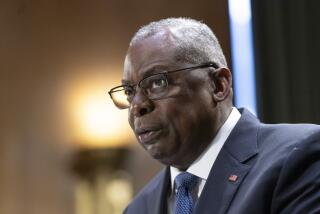Air Force drops ‘mother of all bombs’ in Afghanistan
The U.S. military dropped the most powerful nonnuclear bomb in its arsenal Thursday on a cave-and-tunnel complex that it said was used by Islamic State fighters in eastern Afghanistan, a stark reminder of a U.S. war now in its 16th grinding year.
The behemoth bomb, officially called the Massive Ordnance Air Blast, or MOAB, nicknamed the “mother of all bombs,” is the most powerful bomb the U.S. military has used since dropping the atomic bomb on Nagasaki, Japan, at the end of World War II. It had never been used in combat before.

A GBU-43/B Massive Ordnance Air Blast bomb strikes an ISIS-K cave and tunnel systems in the Achin district of the Nangarhar Province in eastern Afghanistan at 7:32 p.m. local time April 13, 2017.
Its use came less than a week after President Trump, who has put current or retired military officials in senior positions throughout his administration, ordered a retaliatory military strike in Syria. Taken together, the two moves suggest an increased willingness to use overt force by contrast with President Obama, who relied heavily on smaller-scale, covert drone strikes.
But like the Syria strike, use of the monster munition in Afghanistan is more symbolic than tactical, because it is unlikely to change the course of America’s longest war.
President Trump praised the bombing as a “very, very successful mission.” He indicated that he had given the Pentagon a free hand as part of his vow to step up the war on Islamic State.
“We have given them total authorization, and that’s what they’re doing and frankly that’s why they’ve been so successful lately,” he told reporters at the White House.
“If you look at what’s happened over the last eight weeks and compare that really to what’s happened over the past eight years, you’ll see there’s a tremendous difference, tremendous difference,” he said.
Trump also brushed aside questions of whether the use of the bomb was intended to send a message to North Korea, which has been the target of administration saber rattling for weeks.
“I don’t know if this sends a message — it doesn’t make any difference if it does or not. North Korea is a problem; the problem will be taken care of,” he said.
Although the Pentagon’s formal rules of engagement have not changed, military commanders appear to have taken greater liberties in recent weeks — and made more mistakes.
A series of misdirected U.S. airstrikes in Iraq and Syria and a botched ground raid in Yemen have led to a noticeable increase in reported civilian casualties. Earlier Thursday, the U.S. military announced that an airstrike this week had accidentally killed 18 rebel fighters battling Islamic State in northern Syria in the worst friendly-fire incident of that conflict.
The military said the massive bomb was dropped from the rear door of an MC-130 cargo plane at 7:32 p.m. Thursday as part of a U.S.-backed offensive on an Islamic State stronghold in Achin district in the eastern province of Nangarhar. Although huge by the standards of conventional weapons, the bomb is still only a fraction of the strength of a nuclear weapon.
The militants have gained strength in the area, which is close to Pakistan, and have been locked in a pounding ground battle with Afghan security forces backed by U.S. special operations advisors.
Army Staff Sgt. Mark R. De Alencar, a 37-year-old Green Beret from Maryland, was killed on Saturday after coming under fire in eastern Nangarhar. He was the first American service member killed in combat this year in Afghanistan, and the 1,833rd since the U.S.-led invasion in late 2001.
The giant bomb initially falls with a parachute, but a GPS guidance system then guides the bomb to its target.
The munition detonates before it hits the ground, sending a lethal shock wave more than a mile and a half away.
The explosion was intended to send pulverizing pressure through the rocky labyrinth of tunnels, where Islamic State fighters were able to move without being detected by American spy planes, U.S. officials said.
“This is the right munition to reduce these obstacles and maintain the momentum of our offensive,” said Gen. John W. Nicholson Jr., commander of U.S. forces in Afghanistan.
The bomb was moved to Afghanistan before Trump took office, officials said, and Nicholson did not need specific presidential approval to use it, although the White House was briefed.
The Pentagon has 8,400 troops in Afghanistan to train and advise Afghan forces; most rarely participate in direct combat.
White House Press Secretary Sean Spicer said U.S. commanders “took all precautions necessary to prevent civilian casualties and collateral damage as a result of the operation.”
Speaking by phone from Achin, Sher Nabi, a commander with the Afghan Local Police, said the bomb landed about half a mile outside the town of Shogal, near the border with Pakistan.
Nabi, who commands a 60-man unit of the government militia, said Afghan security forces have carried out operations in the area for several days against suspected Islamic State supporters.
Nabi said the bomb killed “many militants” and destroyed their weapons. There were no immediate reports of civilian casualties.
The massive bomb in some ways is a shift from recent Pentagon weapons systems, which use drones and missiles capable of hitting targets through an open window.
Retired Air Force Lt. Gen. David Deptula, now dean of the Mitchell Institute for Aerospace Studies in Arlington, Va., said the bomb was meant to obliterate a wide area and intimidate the enemy.
“With a blast radius of a mile, this weapon wasn’t designed for an urban area,” he said. “It’s going to have physical effects on the enemy, of course, but it is also going to create psychological effects.”
John Pike, director of GlobalSecurity.org, a military policy research website, said the bomb is a “gee-whiz weapon,” not a tactical one.
“You use a bomb like this to send a message,” he said. “It demonstrates that the U.S., despite 15 years of bloody war, is here to stay.”
The bomb was developed in 2002 to “put pressure on then-Iraqi dictator Saddam Hussein to cease and desist or the United States would not only have the means but use them against the unpopular tyrant,” the Air Force said in a 2008 news release.
It was tested at Eglin Air Force Base in Florida but was not used in Iraq. On March 11, 2003, a test produced a mushroom cloud visible from 20 miles away, the release said.
Another U.S. munition, officially called the Massive Ordnance Penetrator, or MOP, is designed to penetrate hardened bunkers. At 30,000 pounds, it is even heavier than the MOAB but carries less explosive power.
Special correspondent Sultan Faizy in Kabul, Afghanistan, contributed to this report.
Twitter: @wjhenn
ALSO
Climate change is real: Just ask the Pentagon
Trump administration stops disclosing troop deployments in Iraq and Syria
U.S. launches dozens of missiles at Syria in response to chemical weapons attack
More to Read
Start your day right
Sign up for Essential California for news, features and recommendations from the L.A. Times and beyond in your inbox six days a week.
You may occasionally receive promotional content from the Los Angeles Times.







